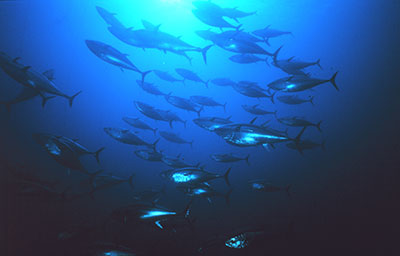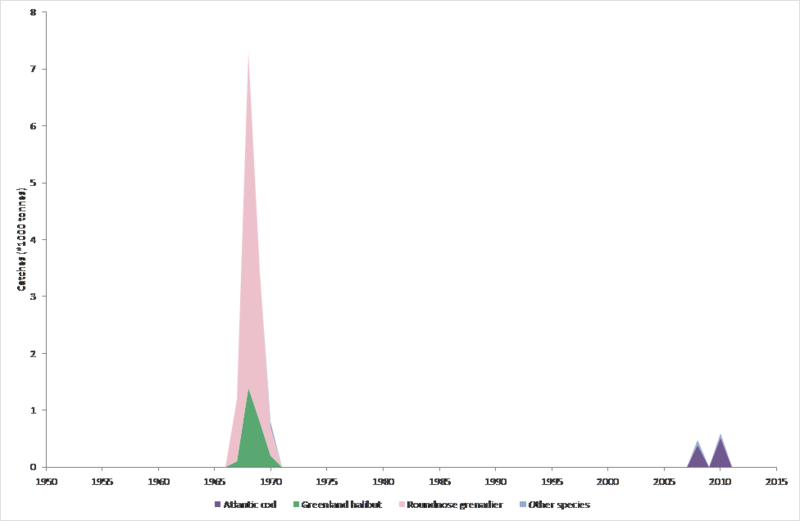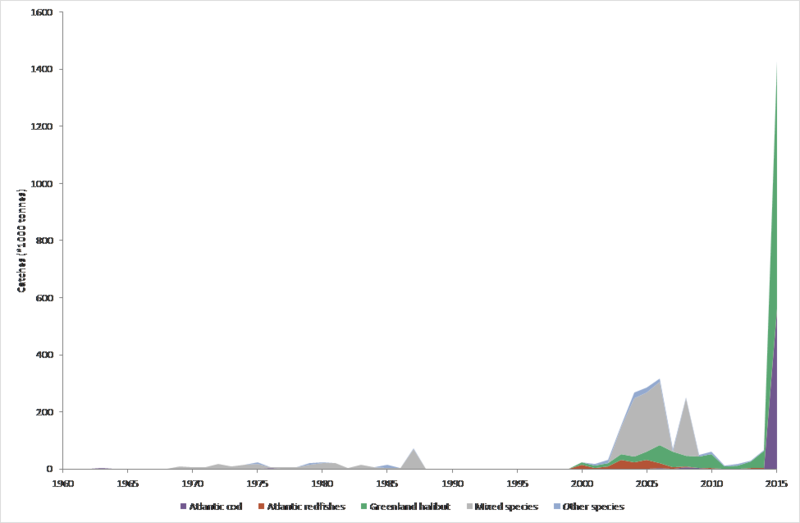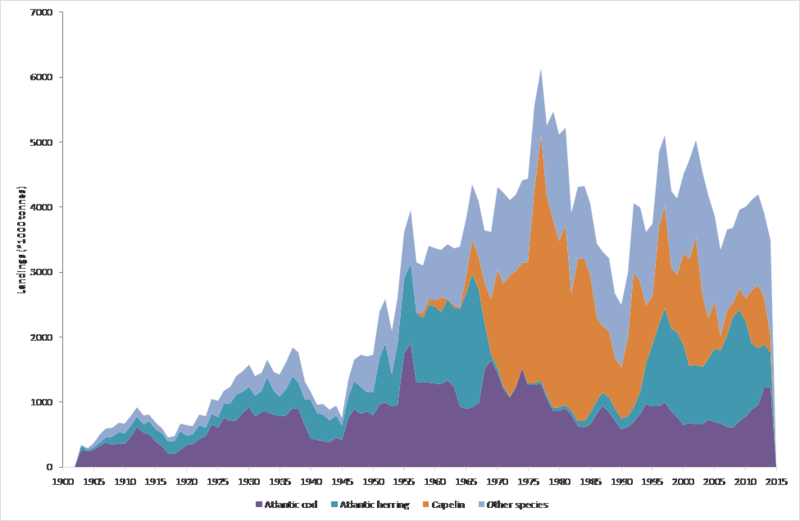Fishery Management

Changes in the Arctic fisheries places increasing importance on fisheries governance and management in the region. However, a significant portion of international waters in the Arctic Ocean is currently not covered by any specific fisheries regulatory framework. The compilation of catch data and identifying knowledge gaps are vital requirements to support management of the region, and could assist by giving:
- Indications of declining historic fisheries
- Indications of new, growing fisheries
- Measures of track records of fishing by different countries across the region as a whole.
This challenge focused on compiling vital fisheries data, i.e. removals by the fisheries.
Objective of the challenge
The objective of this challenge was to produce information tables for the whole sea-basin including:
- mass and number of landings of fish by species and year;
- mass and number of discards and bycatch (of fish, mammals, reptiles and seabirds) by species and year.
These tables include data from before and after the Data Collection Regulation came into force. The time-series is as long as possible, but its length varies between species. The available data has been scrutinised to identify current knowledge gaps while also considering future use of the data.
Main results
Fisheries landings
The term ‘landings’ is used for the portion of catch that is brought to shore, while the term ‘catch’ refers to the total fish captures, whether brought on board the vessel and landed or not (i.e. discards). Because landings exclude these discards, the weight of landings is less than the weight of the catch. It was not always clear whether the data presented for this objective related to commercial fisheries catch or fisheries landings.
Data sets provided by the Food and Agriculture Organization (FAO), the Northwest Atlantic Fisheries Organization (NAFO), and the International Council for the Exploration of the Sea (ICES) were used to compile fisheries landings (or catch) data for the Arctic area.
Figures 2-4 show these first results.

Figure 2: Total annual catch or landings for the Arctic Sea. Source Arctic Sea: FAO

Figure 3: Total annual catch or landings for the Arctic part of the NW Atlantic (NAFO divisions 0A, 1A-F). Source Arctic part of the NW Atlantic: https://www.nafo.int/fisheries/frame

Figure 4: Total annual catch or landings for the Arctic part of the NE Atlantic (ICES areas I, II, Va, XIV). Source: ICES ICES Historical Landings 1903-1949; ICES, Copenhagen, Historical Nominal Catches 1950-2010; ICES, Copenhagen, Official Nominal Catches 2006-2014. ICES, Copenhagen
Discards and bycatch
Within this study the term ‘discards’ refers to that portion of unwanted catch (i.e. fish) which is returned, dead or alive, to the sea. The term ‘bycatch’ in this study refers to incidental catches of mammals, reptiles and seabirds. The amount of discards and bycatch depends on the fishing technique used. Generally, targeted single species fisheries generate few discards but can cause incidental bycatch of megafauna, while mixed fisheries (i.e. fisheries that target several species) may generate higher amounts of discards. Monitoring programmes, such as Observer or self-sampling programmes, are used to estimate the magnitude of discards and/or bycatch in different types of fisheries. Such collected data is not always reported, but can be presented in scientific journals or even in grey literature. Estimates of discards and bycatch are therefore less readily available than landings or catch data.
The available information that was been found on discards and bycatch for the Arctic area is scarce; only fragmented discards and bycatch information was found.
Within this challenge it was therefore not possible to create a comprehensive overview of discards and bycatch for the Arctic area.
Problems and gaps
- The catches in the FAO database for area 18 were thought to be too low to be reliable. Alternative catch reconstructions existed, but these are based on assumptions which made their reliability questionable.
- For the catch data presented here it is not always clear whether it relates to commercial fisheries catch or fisheries landings.
- Collected data on discards and/or bycatch is less readily available than landings or catch data.
Recommendations
- Fisheries on crab, shrimp and shellfish are important benthic fisheries in the Arctic that are not covered in this challenge. Including benthic fisheries is recommended to provide a more thorough indication of fisheries in the Arctic for management purposes.
- It is recommended to allow public access to data on fisheries in the entire Arctic area for scientific and management use. This involves improved access to existing data, and updating international databases with information from national databases. At present, international databases are often lagging several years behind, and they present data in a format that does not provide access to more details via metadata.
Lessons learned
- As the Arctic area only covers parts of the FAO major fishing areas the FAO catch database is not sufficient for use in generating an overview of all landings/catches for the Arctic area. Data also needed to be extracted from the ICES and NAFO databases.
- It is not possible to generate an overall comprehensive overview of discards and bycatch in the Arctic area; only fragmented data has been found.
References
- Bjørge, A. M. Skern-Maurizen & M.C. Rossman, 2013. Estimated bycatch of harbour porpoise (Phocoena phocoena) in two coastal gillnet fisheries in Norway, 2006-2008. Mitigation and implications for conservation. Biological Conservation 161: 164-173.
- CAFF, 1998. Incidental Take of Seabirds in Commercial Fisheries in the Arctic Countries. Technical Report no. 1 from the Circumpolar Seabirds Working Group (CSWG). Editors: V. Bakken & K. Falk. 60 pp.
- EC, 2014. Council Regulation (EC) No 812/2004 of 26.4.2004 laying down measures concerning incidental catches of cetaceans in fisheries amending Regulation (EC) No 88/98.
- Fangel, K., Ø. Aas, J.H. Vølstad, K.M. Bærum, S. Cristensen-Dalsgaard, K. Nedreaas, M. Overvik, L.C. Wold & T. Anker-Nilssen, 2015. Assessing incidental bycatch of seabirds in Norwegian coastal commercial fisheries: Empirical and methodological lessons. Global Ecology and Conservation 4: 127-136.
- ICES, 2015. Report of the Working Group on Bycatch of Protected Species (WGBYC), 2-6 February 2015, ICES Headquarters, Copenhagen, Denmark. ICES CM 2015\ACOM: 26. 82 pp.
- Zeller, D., S. Booth, E. Pakmahov, W. Swartz & D. Pauly (2011). Arctic fisheries catches in Russia, USA and Canada: Baselines for neglected ecosystems. Polar Biology 34(7): 955-973.
